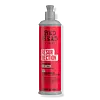What's inside
What's inside
 Key Ingredients
Key Ingredients

No key ingredients
 Benefits
Benefits

 Concerns
Concerns

 Ingredients Side-by-side
Ingredients Side-by-side

Water
Skin ConditioningCetearyl Alcohol
EmollientDimethicone
EmollientStearamidopropyl Dimethylamine
EmulsifyingLactic Acid
BufferingParfum
MaskingBehentrimonium Chloride
PreservativeDipropylene Glycol
HumectantAmodimethicone
Sodium Benzoate
MaskingGluconolactone
Skin ConditioningGlycerin
HumectantSelaginella Lepidophylla Extract
EmollientPotassium Chloride
Trehalose
HumectantDisodium EDTA
PEG-7 Propylheptyl Ether
Emulsion StabilisingPhenoxyethanol
PreservativePropylene Glycol
HumectantCetrimonium Chloride
AntimicrobialSodium Sulfate
Linalool
PerfumingLimonene
PerfumingWater, Cetearyl Alcohol, Dimethicone, Stearamidopropyl Dimethylamine, Lactic Acid, Parfum, Behentrimonium Chloride, Dipropylene Glycol, Amodimethicone, Sodium Benzoate, Gluconolactone, Glycerin, Selaginella Lepidophylla Extract, Potassium Chloride, Trehalose, Disodium EDTA, PEG-7 Propylheptyl Ether, Phenoxyethanol, Propylene Glycol, Cetrimonium Chloride, Sodium Sulfate, Linalool, Limonene
Aloe Barbadensis Leaf
MaskingWater
Skin ConditioningSodium C14-16 Olefin Sulfonate
CleansingCocamidopropyl Betaine
CleansingGlycol Distearate
EmollientPPG-2 Hydroxyethyl Coco/Isostearamide
Cocos Nucifera Water
MaskingButyrospermum Parkii Butter
Skin ConditioningCocos Nucifera Oil
MaskingMacadamia Ternifolia Seed Oil
EmollientPolyquaternium-6
Polyquaternium-10
Sodium Cocoyl Isethionate
CleansingCocamidopropyl Hydroxysultaine
CleansingPEG-120 Methyl Glucose Dioleate
EmulsifyingGuar Hydroxypropyltrimonium Chloride
Skin ConditioningMethyl Gluceth-10
EmulsifyingTapioca Starch
Sodium Chloride
MaskingPropylene Glycol
HumectantDiazolidinyl Urea
PreservativeIodopropynyl Butylcarbamate
PreservativeParfum
MaskingAloe Barbadensis Leaf, Water, Sodium C14-16 Olefin Sulfonate, Cocamidopropyl Betaine, Glycol Distearate, PPG-2 Hydroxyethyl Coco/Isostearamide, Cocos Nucifera Water, Butyrospermum Parkii Butter, Cocos Nucifera Oil, Macadamia Ternifolia Seed Oil, Polyquaternium-6, Polyquaternium-10, Sodium Cocoyl Isethionate, Cocamidopropyl Hydroxysultaine, PEG-120 Methyl Glucose Dioleate, Guar Hydroxypropyltrimonium Chloride, Methyl Gluceth-10, Tapioca Starch, Sodium Chloride, Propylene Glycol, Diazolidinyl Urea, Iodopropynyl Butylcarbamate, Parfum
Ingredients Explained
These ingredients are found in both products.
Ingredients higher up in an ingredient list are typically present in a larger amount.
Parfum is a catch-all term for an ingredient or more that is used to give a scent to products.
Also called "fragrance", this ingredient can be a blend of hundreds of chemicals or plant oils. This means every product with "fragrance" or "parfum" in the ingredients list is a different mixture.
For instance, Habanolide is a proprietary trade name for a specific aroma chemical. When used as a fragrance ingredient in cosmetics, most aroma chemicals fall under the broad labeling category of “FRAGRANCE” or “PARFUM” according to EU and US regulations.
The term 'parfum' or 'fragrance' is not regulated in many countries. In many cases, it is up to the brand to define this term.
For instance, many brands choose to label themselves as "fragrance-free" because they are not using synthetic fragrances. However, their products may still contain ingredients such as essential oils that are considered a fragrance by INCI standards.
One example is Calendula flower extract. Calendula is an essential oil that still imparts a scent or 'fragrance'.
Depending on the blend, the ingredients in the mixture can cause allergies and sensitivities on the skin. Some ingredients that are known EU allergens include linalool and citronellol.
Parfum can also be used to mask or cover an unpleasant scent.
The bottom line is: not all fragrances/parfum/ingredients are created equally. If you are worried about fragrances, we recommend taking a closer look at an ingredient. And of course, we always recommend speaking with a professional.
Learn more about ParfumPropylene Glycol is an odorless, colorless liquid. As a humectant, it helps skin retain moisture. It also aids in delivering active ingredients.
Another role of this ingredient is preventing a product from melting or freezing. Propylene glycol also adds antimicrobrial properties to a product, elongating product lifespan.
This ingredient is considered an organic alcohol and commonly added into both cosmetics and foods.
Those with sensitive skin or conditions may develop a rash when using this ingredient.
Learn more about Propylene GlycolWater. It's the most common cosmetic ingredient of all. You'll usually see it at the top of ingredient lists, meaning that it makes up the largest part of the product.
So why is it so popular? Water most often acts as a solvent - this means that it helps dissolve other ingredients into the formulation.
You'll also recognize water as that liquid we all need to stay alive. If you see this, drink a glass of water. Stay hydrated!
Learn more about Water